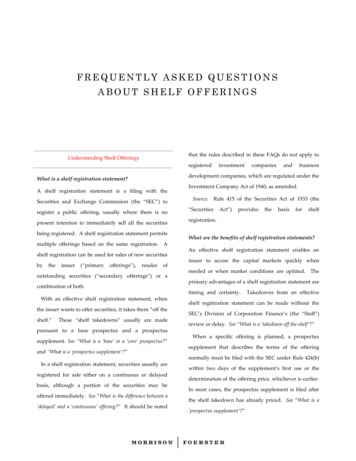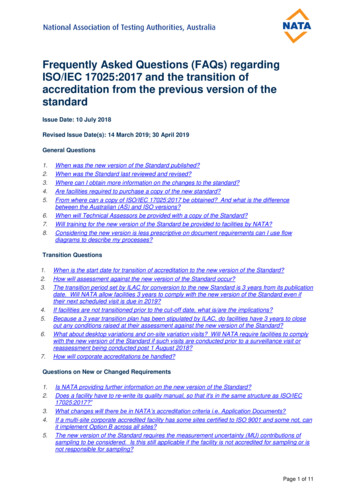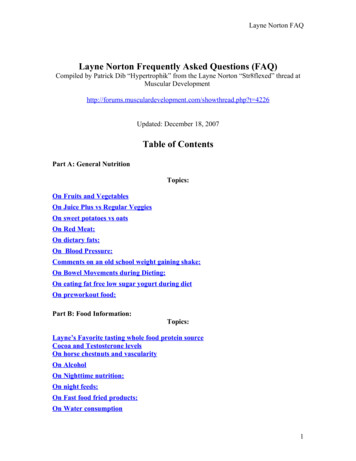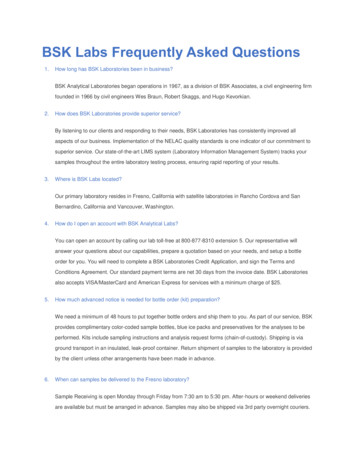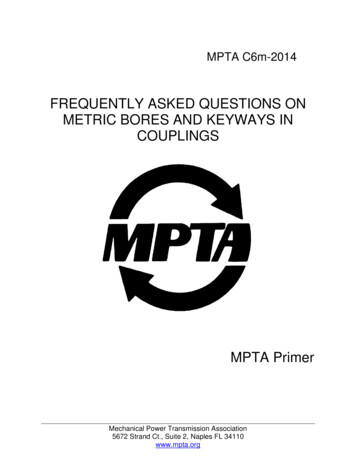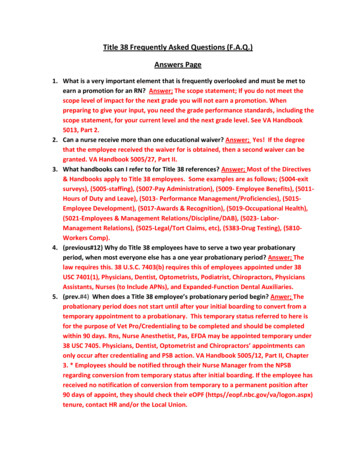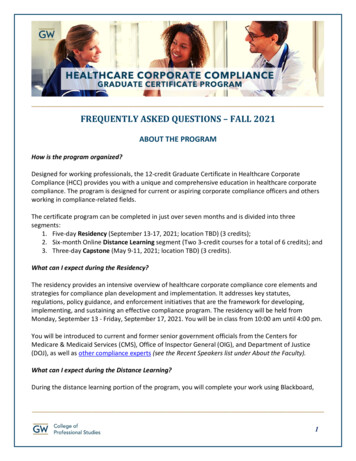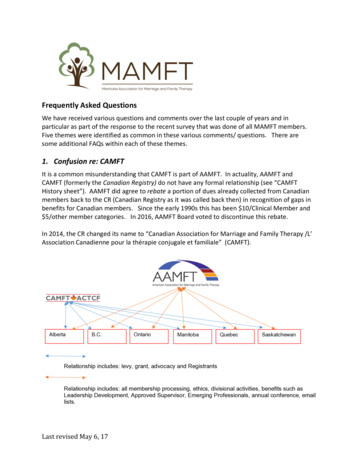
Transcription
Frequently Asked QuestionsWe have received various questions and comments over the last couple of years and inparticular as part of the response to the recent survey that was done of all MAMFT members.Five themes were identified as common in these various comments/ questions. There aresome additional FAQs within each of these themes.1. Confusion re: CAMFTIt is a common misunderstanding that CAMFT is part of AAMFT. In actuality, AAMFT andCAMFT (formerly the Canadian Registry) do not have any formal relationship (see “CAMFTHistory sheet”). AAMFT did agree to rebate a portion of dues already collected from Canadianmembers back to the CR (Canadian Registry as it was called back then) in recognition of gaps inbenefits for Canadian members. Since the early 1990s this has been 10/Clinical Member and 5/other member categories. In 2016, AAMFT Board voted to discontinue this rebate.In 2014, the CR changed its name to “Canadian Association for Marriage and Family Therapy /L’Association Canadienne pour la thérapie conjugaleet familiale” (CAMFT).Current wanRelationship includes: levy, grant, advocacy and RegistrantsRelationship includes: all membership processing, ethics, divisional activities, benefits such asLeadership Development, Approved Supervisor, Emerging Professionals, annual conference, emaillists.Does the Canadian leadership believe and wish to form (if bylaws pass) or maintain (if bylaws don’tpass) a separate membership association from AAMFT that represents the interests of MFTs residingin Canada? Is it time for Canada to create an MFT association on par with such as Ireland, Israel, or theAsianAcademyLastrevisedMayof6,Family17 Therapy?Family Therapy Association of Ireland 300 family therapists.
Who are the members of CAMFT? Aren’t all Canadian MFTs members of CAMFT?The CAMFT is related to the AAMFT through its members and registrants. Members of theCAMFT are the Canadian Divisions (as a whole) of the AAMFT. Each Member (Division) isrepresented by the current President of that Division who serves on the CAMFT Board ofDirectors.Registrants of the CAMFT are Canadian Clinical Fellows of AAMFT.Currently, individuals from other member categories of AAMFT are not represented by aspecific membership category however the CAMFT is committed to promoting the interests andcommunities served by all MFTs in Canada and receives funding to support Canadian AAMFTmembers in all categories.In 2017 CAMFT is drafting changes to its by-laws to change the members from being divisions tobeing individual members. Then each MFT member will have a direct relationship with CAMFT.If the AAMFT vote for restructuring passes, then there will also be a need to consider howindividual members will connect with CAMFT. Under the potential new AAMFT by-laws,individual members will not automatically be part of divisions or any Canadian entity related toAAFMT. Members will have a choice as to whether to also join other interest networks andCAMFT (in whatever way it is structured in the future).CAMFT is currently considering various options and has been surveying Canadian MFTs to gettheir input for desired direction of CAMFT.In May 2017, CAMFT met with leadership of AAMFT and spent two full days brainstorming,analyzing and exploring possible options for a different kind of relationship between a Canadianwide group of MFT with AAMFT. AAMFT is bringing these ideas back to their Board and wehope to hear soon what possibilities they see for partnering for continuing to promote theprofession collaboratively. Any new structure between AAMFT and a potential CAMFT willlikely unfold over several years.The key concern is that we have a professional community that supports and promotes MFT asa distinct profession in a way that is relevant and supportive of our Canadian context.CAMFT will continue to update Canadian MFTs as we learn more and promote MFT in Canada.It will be up to Canadian MFTs to choose where to invest in a professional home.Last revised May 6, 17
2. Confusion re: RMFT designation. What is it? Who gets it?Clinical Fellows are the highest level membership within AAMFT and are Registrants in CAMFT.Registrants (Clinical Fellows) are given the credential “Registered Marriage and FamilyTherapist” or “RMFT”, indicating standing as a Clinical Fellow with AAMFT. This is highly valuedby many MFTS across Canada. In jurisdictions without regulation in particular, this is often acredential that is recognized by employers, clients and peers as indicating a particular level ofeducation and training.What is the relevance then of CAMFT for Student, Affiliate or Pre-Clinical members?CAMFT works to support all Canadian MFTs in the following ways: The CAMFT provides benefits that the AAMFT has been unable to provide for Canadianmembers such as competitive rates for professional liability insurance through McFarlanRowlands. The CAMFT has successfully lobbied for the inclusion of RMFTs as recognized providersfor Canadian veterans through Medavie/Blue Cross and to be recognized by theDepartment of National Defence. The CAMFT continues to seek the increasedrecognition of RMFTs in 3rd party payments plans. Increasingly we see individualinsurance companies across Canada recognizing MFTs in their coverage. Provide information to Canadian AAMFT Divisions such as giving Divisions timelyinformation and analysis about the AAMFT restructuring proposals and the implicationsfor Canadian members. Provide quality national conferences to bring our professionals together. In 2016 ConnieElliot was featured, presenting on using Solution Focused Couples Therapy. “Find a Canadian Registered Marriage and Family Therapist” section of the new CAMFTwebsite – this is a free benefit for CAMFT registrants to connect members of the publicseeking therapy services to an RMFT practicing in their region of Canada. Free listings for MFT job postings are free to post at any time. Networking and presenting at events nationally representing MFTs.Last revised May 6, 17
3. What is happening with the AAMFT restructuring vote in 2017? What will thismean for Canadian members if it passes?The AAMFT Board is recommending the following structural change to the AAMFTmembership for ratification (vote):(see Bylaws Proposal One-Pager handout) That a 2-tier membership will no longer be mandatory, AAMFT will no longer requiremembers to join a Division in addition to AAMFT as part of their membership. AAMFT Divisions will be dissolved and optional Special Interest Groups (SIGs) could becreated based on geography, topic or issue (eg. Florida SIG, adoption SIG, advocacy SIG). SIGs will be temporary structures created when a need or desire is identified through anapplication process with a defined minimum numbers of applicants. A SIG will cease to exist if membership drops blow a specified level.How will this affect what member pays for dues to the AAMFT?Fees would be reduced in certain circumstances - presently the fee structure is comprised ofthe AAMFT due ( 201), plus the Division due. The new fee would be 201 plus optional dues foreach special interest group (SIG) one chooses to join. It is unknown if AAFMT due will remainthe same. The dues for SIGs would be in the likely range of 30 to 50 each. If a person joinsseveral interest groups, the fees would be comparable or potentially higher. If only one or twointerest groups are joined the fees would be lower in most cases.If the membership votes to ratify the motion for a one-tier AAMFT, what will replaceState/Provincial Divisions?If the resolution passes, AAMFT State and Provincial Divisions will be dissolved. There will be noState/Provincial entity that is officially connected, supported and funded through AAMFT. A special Interest Group (SIG) could form around the same geographic location as a formerDivision if there is sufficient numbers petitioning to form it among other requirements.Membership in a geographic SIG would be strictly optional. MAMFT is leaning toward this. A Division could become an independent association following a vote to ratify the motion.In this scenario, the Division would be entirely independent from AAMFT, would not receiveLast revised May 6, 17
any portion of AAMFT dues, would not receive staff support from AAMFT and would haveno charter affiliation with AAMFT.What happens to membership certification eg. “Clinical Fellow”? Will maintainingcertification require a member to maintain AAMFT membership and pay AAMFT dues?Currently AAMFT provides the certification Clinical Fellow for those members who meet thecriteria for the category and are members in good standing (ie. Dues are paid). MaintainingAAMFT certification will require continued membership with AAMFT following a restructuring.How will advocacy be taken care of if the membership votes to dissolve Divisions given thatmost legislation impacting the MFT profession is based at the State/Provincial level?Under the newly proposed structure, all members with an interest in advocacy would jointogether in a large advocacy special interest group. If a local geographic interest network is setup, it is possible local efforts could continue through this group. There may be some access togeneral support from AAMFT.What are the risks of the restructuring proposal for Canadian members who reside injurisdictions where MFTs are not regulated?The risks of the restructuring are likely far greater for Canada members as a mostly unregulatedenvironment for MFT’s (except for Quebec where MFTs have practice and title protection andOntario where they are regulated if they join a College that regulates Psychotherapy butwithout title or practice protection).Health services are provincial jurisdictions - to dissolve Divisions would potentially underminethe ability of MFTs in an unlicensed province to negotiate given that governments typically donot negotiate with groups that do not have provincial representation.It is key to note that one division has regulation and title protection(Quebec), one division hasaccess to regulation, but with no title protection(Ontario) and two divisions are quite close toachieving some kind of regulation in the relatively near future (Alberta and BC). The moreregions with regulation, the more pressure this adds on governments in other regions as well.What are Special Interest Groups, how are they created and governed?Special Interest Groups (SIGs), are groups comprised of members of a larger association thatare organized around specific interests. SIGs develop from shared interest among subjectmatter areas, locality (city/province/state/regions), and issue-oriented work. Special interestgroups can be created for several reasons: (1) to meet a permanent need or area of focus likeadvocacy; (2) to address a sub-segment/topic of interest within a profession over time; (3) tomeet a temporary and emergent need. Interest groups are typically intended to exist on atemporary basis and have a developmental growth curve: originate and form, develop, cease.So in theory, a person would join AAMFT and then would have choice to join as many differentSIGS they choose. If there is a local geographic interest network or group, it will be up to eachmember to choose whether to join it or not.Last revised May 6, 17
4. Clear Support for Canadian Association for MFTIn our recent survey re: interest and value of RMFT and CAMFT, we heard from half of you!That is an excellent response rate on a survey in an organization like ours. Thank you for yourparticipation.Of those who responded, there is a clear desire for the continuation and expansion of aCanadian MFT presence. Approximately 85 % of you stated the RMFT designation, which is acredential granted specifically by CAMFT, is important to you, and also that you would bewilling to support an association to be able to retain this credential.In your comments it is clear that there is an appetite for a more articulated Canadianassociation. There are also questions that some of you have and some concerns by some thatthere is not enough value in the RMFT or the CAMFT as they stand now.5. What will happen to MAMFT?We have a robust division in MAMFT. We have a growing membership. We have a highnumber of student and Pre-Clinical members who do, for the most part, go on to becomeClinical Members.We have a steady turnout of 20 – 30 % of our membership at our events, small workshops andannual meetings. From these members we have heard clearly the call for ongoing connection,face-to-face meetings and community work to raise the profile of MFTs in our province. Thereis also a desire to continue the hard work seeking regulation of our profession. Although thereis currently no political will in the government of the day, we are pursuing solidification of ourpresence, initiating research into the value and need for regulation of MFTs in Manitoba, andworking to build relationships with other service providers and bodies seeking regulation.MAMFT will continue to offer opportunities for learning, networking and connecting as an MFTcommunity through our events, newsletter, website and social media as long as we are underour current structure.If the vote passes and our division dissolves, we will likely pursue setting up a geographicinterest network, possibly inviting our Saskatchewan neighbours to join us. It will remain to beseen if Manitoba MFTs will choose to belong to such a group, and what its future and focus willbe.Keep asking questions, keep informed and learn about the evolving landscape for MFTglobally.Last revised May 6, 17
CAMFT works to support all Canadian MFTs in the following ways: The CAMFT provides benefits that the AAMFT has been unable to provide for Canadian members such as competitive rates for professional liability insurance through McFarlan Rowlands. The CAMFT has successfully lobbied for the inclusion of RMFTs as recognized providers


